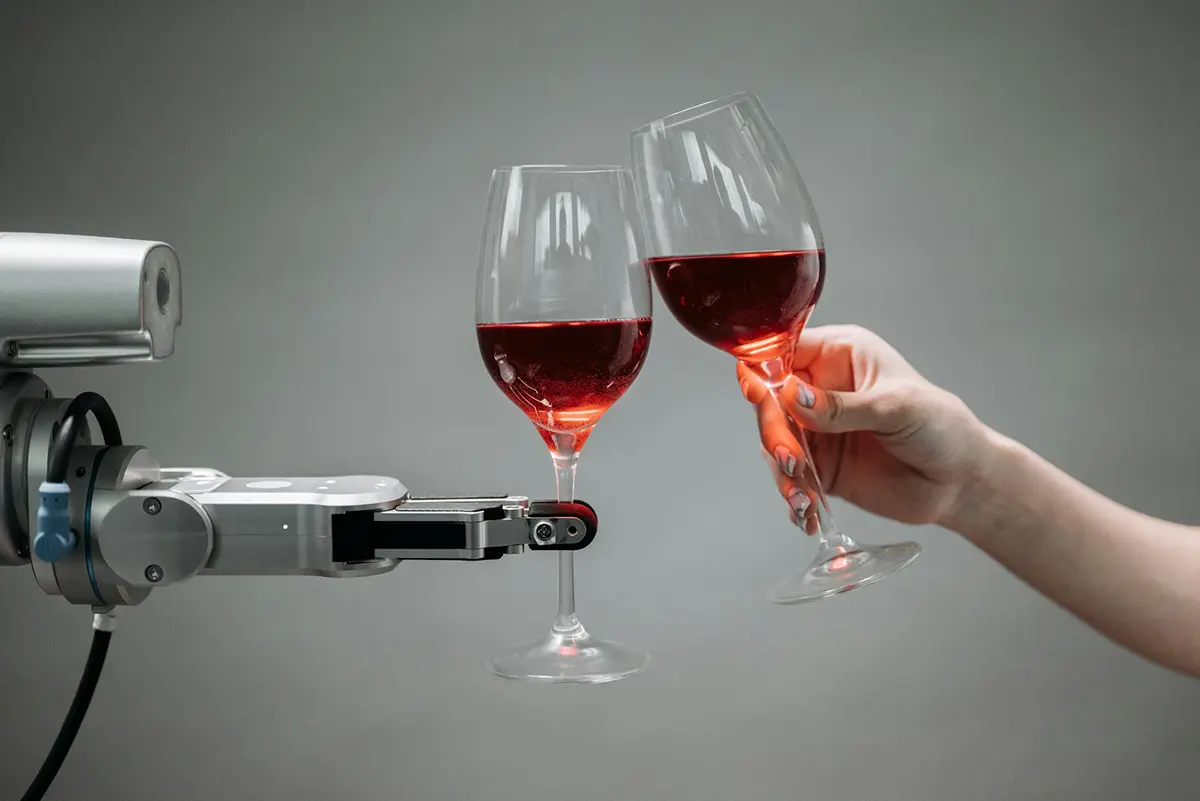If you have been scrolling on LinkedIn or any of the TA/HR news sites in the past year, chances are you have seen at least a couple of articles discussing the future impact of AI on recruitment.
Opinions usually range from excitement about the chance to eliminate some of the least favorite tasks of recruiters with AI to people proclaiming that fully AI-based recruitment is the future and human recruiters will be made obsolete. Among all this hype, there are a few critical voices highlighting that personal connections between recruiters and candidates will suffer from involving artificial intelligence in the hiring process. Naturally, this has candidates worried that more AI tools will only lead to more (personalized) spam in their LinkedIn or email inboxes.
Given that we at headcount pride ourselves in using digital tools and automation in the right way, these are plenty of reasons for us to take a closer look: how can AI be used in recruitment, what are the pros and cons, and do robot recruiters dream of electric sheep?
Where (and when) AI can really help: Benefits of using AI in recruiting
Figuring out the best way to use artificial intelligence in your specific recruiting process will depend mostly on the context of your organization. The specific pains AI can address for you will be very different if you are working at a boutique executive search firm, or doing in house recruitment at a multinational company with hundreds of open positions per year.
For smaller agencies, AI can significantly reduce administrative time by automating tasks like updating candidates on their processes, replying to off-hours candidate queries, and interview scheduling. It can also enhance your CRM by efficiently screening resumes and organizing them in applicant tracking systems (ATS), making recruitment management more streamlined. Indeed, the potential integration in existing platforms is the most promising and cost-effective avenue to leverage AI for boutique agencies.
Larger agencies, on the other hand, will also be able to leverage AI technologies in the recruitment process to scale their pipelines by reaching out to more candidates while using AI to select the most promising targets, and use AI generated content to still achieve a personalized approach

For large multinational companies, AI-based recruitment is a comprehensive strategy in the global talent war¹. It extends the talent pipeline to all online profiles, automates engagement with promising candidates, and handles initial preselection, reserving human recruiters for the final stages. For them, AI’s predictive analytics will become crucial in candidate evaluation, analyzing resumes, social media, and online behavior to predict role suitability, aiding their recruiters in informed decision-making. In-house, AI might also excel at identifying critical positions and engaging the talent community with relevant new openings, ensuring a dynamic and responsive recruitment strategy.
Artificial Intelligence's role in recruiting: Where it’s worth - and where it’s not
If you came here wondering if recruitment will be automated, the answer is that this has been happening already for quite a long time. Automation of candidate outreach, interview scheduling, and communication along the recruitment process has long been an active area of technological progress for in-house recruitment and outbound recruiting agencies alike.
The growth of potential candidate pools through globalization and the massive adoption of online career platforms, combined with the increasing competition between multinational companies for the most skilled workers, known as the war for talent, have massively boosted the number of candidate interactions that need to be handled by agency and in-house recruiters alike. Recruitment has been fairly quick to adopt digital automation tools offered by services such as LinkedIn Recruiter and many applicant tracking softwares (ATS).
Thus, when talking about AI technologies in recruiting, we should distinguish between simple automation, generative artificial intelligence (GAI) – used largely in candidate communication and some aspects of sourcing, such as generating boolean search string – and AI-based candidate screening and selection algorithms (AI-based recruitment). So let’s dive into the latter two technologies and look at different scenarios for their appropriate use.
Recruiting between automation, GAI and AI-based selection algorithms
The (already) existing infrastructure of digital automation tools and ATS meant that the rise in quality and availability of GAI tools throughout 2023 quickly led to first experiments trying to personalize these communications by feeding information about candidates to the large language models (LLMs) underlying these technologies and adapting the tone of voice of the company or agency into the outgoing communications.
Beyond candidate communication, generating a larger variety of boolean search strings for a given job has become much simpler, as LLMs with their vast repertoire of synonyms and variations of a common theme excel in this area. Writing job descriptions, while not a massive pain for recruiters in terms of time invested, is another obvious target for GAI, and one that is certainly achievable. Therefore, the addition of GAI tools to the recruiter’s toolbox can be viewed as just another step in the automation of repetitive tasks, and in my view, does not fundamentally change the nature of recruitment, as long as they are used in the right way.

Currently, you still have to implement many of these tools manually using your preferred online GAI tool, but recent announcements by LinkedIn and several CRM/ATS providers show that all of this will soon become highly integrated into the platforms that are used by the majority of TA professionals, which will massively boost adoption of these tools. Proponents of the technology emphasize how this will help professionals to automate more of the repetitive tasks of their job and get a better handle on the scale of modern recruitment pipelines. Ultimately, this should allow them to focus more on the human parts of recruitment: understanding the client’s needs, presenting a job to candidates, evaluating the candidate fit, negotiating employment terms, etc.
On the other hand, AI-based recruitment, or the use of AI for candidate sourcing, evaluation and selection, has much further reaching implications, and is therefore also much more controversial. Before we discuss those in detail, let us consider the pros and cons of some of the most common AI tools that are available to most recruiters today.
AI technologies for recruitment: An overview
The current landscape of recruitment technologies is marked by a significant leap in automation and efficiency. One of the key technologies in this field is automated interview scheduling. This technology streamlines the process of coordinating interviews, reducing the manual workload on recruiters and improving the candidate experience. Furthermore, automation with GAI can play a pivotal role in maintaining regular engagement with the talent pool, ensuring consistent check-ups with placed candidates and fostering ongoing communication with the talent community.

Another area where AI is enabling progress is in generative communication. Tools like chatbots and automated email systems are revolutionizing how companies interact with candidates. They handle tasks such as confirming the reception of documents and providing status updates, thereby enhancing candidate engagement and reducing response times. The introduction of custom GPTs by OpenAI together with WordPress plugins makes it feasible even for smaller agencies or companies to train a custom chatbot that can answer questions about their recruitment process and help candidates to assemble their application documents. In the realm of content creation, AI’s generative capabilities extend to writing job ads and marketing content, making these processes more efficient and tailored to the target audience.
AI is also transforming the sourcing process. It enables the generation of numerous variations of boolean search strings, thus helping recruiters uncover profiles that might otherwise be missed. Moreover, AI’s advanced methods, including natural language processing of profiles and CVs, contribute to more effective candidate sourcing. These technologies allow companies to identify potential candidates in their own database or online platforms, who may not have actively applied for the job but possess the requisite skills, thus broadening the talent pool and strengthening recruitment strategies.
How recruitment automation is reshaping the future of hiring
Looking ahead, the future of AI in recruitment holds even more promising advancements. A significant area of development is in preselection. AI systems are expected to become more adept at screening through large volumes of resumes, effectively matching job requirements with candidates’ qualifications and experience
This advancement will not only streamline the recruitment process but also ensure a higher quality of candidate shortlisting.
Proponents of AI-based recruitment argue that this would only be the first step toward a fully AI-assed selection process. The integration of AI and automation technologies into Applicant Tracking Systems (ATS) and recruitment Customer Relationship Management (CRM) systems is another key area of future development. The use of AI in these systems will lead to more intelligent and responsive platforms, capable of handling various aspects of the recruitment process in a more interconnected and personalized manner, while allowing the further upscaling of recruitment pipelines.

Lastly, AI is set to revolutionize access to passive job candidates, intensifying competition for talent. By leveraging extensive data analysis and predictive algorithms, AI will enable companies to tap into a broader talent pool, reaching out at scale to candidates who might not be actively seeking new opportunities but are a perfect fit for the role. This broad access to talent, facilitated by generative AI and AI-based sourcing, will reshape the recruitment landscape, making it more dynamic, but also even more competitive.
Downsides of AI in recruitment - Not all that glitters is gold
On the other hand, skeptics raise valid concerns that, if used at scale, these tools might simply increase the amount of poorly targeted outreach and lead to frustration on the side of candidates, who feel fooled into believing that the more personalized messages generated by the GAI indicate a heightened interest on the side of the recruiter. Hence, they might quickly grow numb and view it as essentially identical to the mass automated approaches and responses we have collectively grown accustomed to over the last decade.
This is just the tip of the iceberg of potential issues with mass adoption of GAI and further scaling of talent pipelines. Others are:
Data privacy
Here, the concerns will only grow the more digital tools are added to the recruitment tech stack. Obtaining informed consent from all candidates in their pipeline will be incredibly challenging for large companies.
Increased competition
Experts are predicting an ensuing arms race in the war for talent for the most powerful AI tools to reach the most candidates, and while automating repetitive tasks might indeed free up time on the recruiters side to focus on tasks that are perceived as more essential, candidates might struggle with increased competition and never progress to the stages of the recruitment process where they would reap the real benefits of the new, more personalized approach.
Reliability of AI assessment methods
The accuracy and validity of AI assessment methods in recruiting will surely be hotly debated the more they are used in preselection, and the transparency and explainability of the algorithms decisions will be a crucial task for the developers of these methods.
Could the answer to the issues brought about by the partial adoption of GAI and automation be turning to fully AI based recruitment?
How AI can erase or boost recruitment biases
Interestingly, it is a good point, at least in certain contexts. Having established that the digitalization of recruitment and increasingly globalized careers have increased the number of applications for jobs, the logical consequence is that a smaller and smaller fraction of the applicants can actually be reviewed by a human recruiter.
The same applies for outbound recruiting and growing talent pools in internal databases and public online career platforms.
This effect is commonly acknowledged to be a major hurdle in the way of a more diverse workforce, as humans with limited resources and increasing time pressure are more likely to follow their unconscious biases when deciding whose profile deserves a closer look.
Many experts argue that this is a major reason for commonly observed patterns of preferences of companies for candidates from certain universities, nationalities, age groups, or genders.

These experts go on to argue that these biases are in the way of truly skill-based hiring, which would benefit employers by making sure that the candidate with the best specific qualification is chosen over the one with more attributes that are seen as generally favorable through the biased lens of a human recruiter. Thus, an algorithmic system that is free of such biases² could lead to more objective decisions without bending under the sheer number of profiles to review. Human recruiters could still play a role further down the road to a hiring decision, now operating on a field of (hopefully) more diverse candidates.
AI safety experts are quick to point out that, being trained on human generated content, AI algorithms have been shown to exhibit many of the same biases³. Indeed, a rule-based model could potentially be more suitable than more complex general purpose AIs, whose decision making processes are much more difficult to evaluate.
Could a bias-free AI-run hiring process become real?
Given that a proven bias-free system could become available in the future, a purely AI-run TA department or recruiting agency does not seem too far-fetched anymore. And it could work just like this.
- Job descriptions generated by a language model
- Job offers automatically sent out with a personalized approach to candidates fitting the profile
- Candidate profiles sourced by the thousands of appropriate search strings generated by a specialized sourcing algorithm.
- Positive responses are then evaluated by a purely skills-oriented selection algorithm
Perhaps the AI could even lead optimal salary negotiations through its impeccable understanding of game theory and simply presents a handful of final options to the final decision makers! While this might still sound very futuristic and perhaps dystopian to most, who is to say that some companies would not be willing to give such a system a try? In the war for talent between the largest multinational companies, it could be a powerful weapon indeed, as it can process volumes of candidates far greater than any human TA team.
However, smaller companies or industries that are less suited for the fully hard skill-based approach could turn this to their advantage, by providing a much more personalized experience to candidates and leveraging the flexibility and precise targeting offered by smaller, more effective talent pipelines, such as those provided by specialized boutique recruitment agencies. Hiring a diverse workforce still mainly depends on understanding the needs of different candidate populations to develop the appropriate incentives to motivate them to apply. Thus, maybe using GAI to reach out to underrepresented populations on a larger scale is the most appropriate current use of AI to fight inherent recruiting biases.
Human Relationships vs AI - Integrating AI in hiring processes without destroying relationships
Having established their potential usefulness, let address the frequent criticism of AI generated communications by traditionally-minded recruiters. They caution that such content might alienate candidates, who often prefer genuine interactions with flesh-and-blood recruiters. Indeed, the contrast between a cold, robotic message—or worse, a bad AI impersonation of a human—and a real human interaction is stark. However, I contend that current GAI tools like the GPT model developed by OpenAI, can be tuned very effectively to emulate the tone of voice of a company.
Thus, when used appropriately, can actually augment the relationship between candidates and recruiters, instead of undermining it.
How? By taking care of the daily, small process updates and replies to common queries, and freeing the recruiters minds to take on the important and difficult conversations.

Furthermore, AI, particularly in the form of conversational AI or chatbots, has significantly evolved to streamline the candidate engagement process. These tools can manage key qualifying questions and simplify time-consuming recruitment tasks, all while maintaining engagement and tracking responses, thereby enhancing the overall recruitment experience. For instance…
- Wouldn’t it be preferable to receive immediate notification from a chatbot if your profile doesn’t meet basic job requirements, as opposed to waiting weeks for a response from an overwhelmed human recruiter?
- Wouldn’t be good to get a friendly, personalized message from a recruiter’s AI assistant about a new job opening that suits you, rather than being lost in the vast talent pool of a multinational company?
This automation allows recruiters to focus more on aspects that require human touch, such as empathy and relationship building, crucial elements in the talent acquisition process that we believe AI cannot replicate (yet?).
How AI is used in headcount - and why
At Headcount, we recognize the strategic importance of AI in modern recruiting, particularly in the fiercely competitive landscape for talent. To leverage many of its benefits while avoiding the common pitfalls I listed throughout this article, we came up with some guiding principles. Our approach to leveraging AI strikes a balance between technological efficiency and the essential human touch. Firstly, we believe in being transparent about our use of AI tools and never disguise AI-generated content or automations as human interactions. For example, while we are exploring the use of AI-assisted sourcing to target a wider candidate pool, we ensure that our response to this influx is carefully managed. We are conscious that candidates remember the quality of interactions, and we avoid overwhelming them with irrelevant communications.
Secondly, as candidates progress further along the recruitment pipeline, our approach becomes increasingly personalized. We understand that while AI can aid in the preliminary stages of recruitment, the key decisions and communications should always be handled in a personalized and human manner. This is especially crucial when communicating important decisions to candidates. Our philosophy is that candidates and clients should feel that they are being evaluated and engaged with by empathetic and adequately qualified human professionals, rather than solely by an algorithm.
This human-centric approach ensures that while we utilize AI for its strengths in making the hiring process more efficient and broadening our talent pool, we also maintain the human element that is crucial in recruitment.
Key decisions are always justified and taken by human actors at Headcount, ensuring a balanced and thoughtful recruitment process that respects the individuality of each candidate and upholds the values of our agency.



